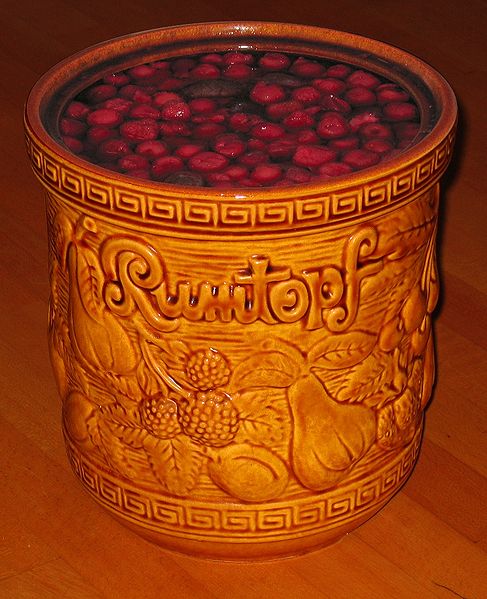Downloads:

General information
Recipe and further information
Keywords
Traditional, preservation, fruit, dessert, seasonal
Level

General information
This is a traditional recipe of Northern European Countries, when preserving fruits for winter was important. The peculiar feature of this recipe is that the preparation lasts….one year.
Specific pots are used (in thick ceramic or similar material, with a lid), usually more than 4 lt. capacity; can be found find on line. As an alternative, you can use a big vase, making it light proof with layers of aluminium. It is important that the vase is sealed (with fold film + a lid) and kept in a cool and dark place (a cellar or a closet).
The principle is easy: every month or so, beginning in spring (or earlier, in warmer countries), you add one layer of fresh fruit previously macerated for one hour in half their weight of sugar. You then cover it up with Rhum so that no fruit is exposed to air, seal the vase with film, put the lid on and store in a dark and cool place.
Traditionally, the pot was opened on the first Advent’s Sunday, or on Christmas’ Eve. The mixture is stirred to mix all different fruits, and is served as a dessert or to enrich ice cream, pudding, cakes. A cocktail can also be made putting a piece of fruit in a glass and filling it with champagne.
Recipe and further information
Recipe:
- Fresh fruit; washed, peeled, seeded, cut in pieces as necessary (small fruits are left whole)
- Half its weight of sugar
- Rum (55°, in some Countries 40° only is sold)
- Prepare the fruit and weight it.
- Mix it with half the weight (some use 40%) of sugar, leave it to macerate for one hour. Pears are to be cut in quarters and washed in a mix of sugar and warm water.
- Add the fruit in the vase, cover well with rum (at least 1 cm. over fruit).
- Seal the vase with plastic wrap, cover with lid, store it in a cool and dark place.
Fruit calendar (to be adapted to the region/country and to personal taste):
- April: strawberries (whole or cut in two)
- May: cherries (pitted)
- June: apricots, peaches (peeled)
- July: plums (pitted)
- August: red fruits (choose very hard ones)
- September: grapes (in halves, pitted)
- October: pears (see above)
- November: according to German tradition, pineapple (this is not a typical fruit, but the tradition calls for it).
NOTE: it is better to avoid the following fruits:
- Apples and bananas (texture becomes strange)
- Melon and watermelon (too watery)
- Rhubarb, lemon (sour)
Black or Blue berries (will turn everything purple)
Description
This is a traditional recipe of Northern European Countries, when preserving fruits for winter was important. The peculiar feature of this recipe is that the preparation lasts….one year.
Specific pots are used (in thick ceramic or similar material, with a lid), usually more than 4 lt. capacity; can be found find on line. As an alternative, you can use a big vase, making it light proof with layers of aluminium. It is important that the vase is sealed (with fold film + a lid) and kept in a cool and dark place (a cellar or a closet).
The principle is easy: every month or so, beginning in spring (or earlier, in warmer countries), you add one layer of fresh fruit previously macerated for one hour in half their weight of sugar. You then cover it up with Rhum so that no fruit is exposed to air, seal the vase with film, put the lid on and store in a dark and cool place.
Traditionally, the pot was opened on the first Advent’s Sunday, or on Christmas’ Eve. The mixture is stirred to mix all different fruits, and is served as a dessert or to enrich ice cream, pudding, cakes. A cocktail can also be made putting a piece of fruit in a glass and filling it with champagne.
Labels
Benefits
Based mainly on local fruits, the recipe is 0 Km.
This is a very traditional recipe. According to the legend, it started when Rum was imported to Europe in the XVIII century, through the German harbour of Flensburg, the seat of the West Indies fleet, where it started its journey throughout the continent. Importers of Rum from the Caribbean tried to import tropical fruits, too, and found this way (preserving in Rum), probably accidentally when some pieces of fruit fell into Rum barrels.
Representative Products
Fresh seasonal fruits.
Risks
Alcohol or products containing alcohol should be consumed by adults only, in moderation. Pregnant women should avoid alcoholic products.
Further references
https://www.food.com/recipe/rumtopf-traditional-german-fruit-preserve-beverage-140344
https://germangirlinamerica.com/rumtopf-how-to-make-rumtopf/
 Play Audio
Play Audio

